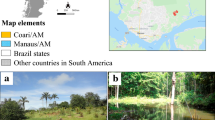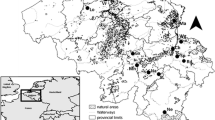Abstract
The symbiotic relationship between Asaia, an α-proteobacterium belonging to the family Acetobacteriaceae, and mosquitoes has been studied mainly in the Asian malaria vector Anopheles stephensi. Thus, we have investigated the nature of the association between Asaia and the major Afro-tropical malaria vector Anopheles gambiae. We have isolated Asaia from different wild and laboratory reared colonies of A. gambiae, and it was detected by PCR in all the developmental stages of the mosquito and in all the specimens analyzed. Additionally, we have shown that it localizes in the midgut, salivary glands and reproductive organs. Using recombinant strains of Asaia expressing fluorescent proteins, we have demonstrated the ability of the bacterium to colonize A. gambiae mosquitoes with a pattern similar to that described for A. stephensi. Finally, fluorescent in situ hybridization on the reproductive tract of females of A. gambiae showed a concentration of Asaia at the very periphery of the eggs, suggesting that transmission of Asaia from mother to offspring is likely mediated by a mechanism of egg-smearing. We suggest that Asaia has potential for use in the paratransgenic control of malaria transmitted by A. gambiae.






Similar content being viewed by others
References
Beier JC (1998) Malaria parasite development in mosquitoes. Annu Rev Entomol 43:519–543, Review
Breman JG, Alilio MS, Mills A (2004) Conquering the intolerable burden of malaria: what's new, what's needed: a summary. Am J Trop Med Hyg 71:1–15
Crotti E, Damiani C, Pajoro M, Gonella E, Rizzi A, Ricci I, Negri I, Scuppa P, Rossi P, Ballarini P, Raddadi N, Marzorati M, Sacchi L, Clementi E, Genchi M, Mandrioli M, Bandi C, Favia G, Alma A, Daffonchio D (2009) Asaia, a versatile acetic acid bacterial symbiont, capable of cross-colonizing insects of phylogenetically-distant genera and orders. Environ Microbiol 11:3252–3264
Damiani C, Ricci I, Crotti E, Rossi P, Rizzi A, Scuppa P, Esposito F, Bandi C, Daffonchio D, Favia G (2008) Paternal transmission of symbiotic bacteria in malaria vectors. Curr Biol 18:1087–1088
Daims H, Brühl A, Amann R, Schleifer KH, Wagner M (1999) The domain-specific probe EUB338 is insufficient for the detection of all Bacteria: development and evaluation of a more comprehensive probe set. Syst Appl Microbiol 22:434–444
Douglas AE (1989) Mycetocyte symbiosis in insects. Biol Rev Camb Philos Soc 64:409–434, Review
Edgar RC (2004) MUSCLE: multiple sequence alignment with high accuracy and high throughput. Nucleic Acids Res 32:1792–1797
Favia G, Dimopoulos G, della Torre A, Touré YT, Coluzzi M, Louis C (1994) Polymorphisms detected by random PCR distinguish between different chromosomal forms of Anopheles gambiae. Proc Natl Acad Sci USA 91:10315–10319
Favia G, Ricci I, Damiani C, Raddadi N, Crotti E, Marzorati M, Rizzi A, Urso R, Brusetti L, Borin S, Mora D, Scuppa P, Pasqualini L, Clementi E, Genchi M, Corona S, Negri I, Grandi G, Alma A, Kramer L, Esposito F, Bandi C, Sacchi L, Daffonchio D (2007) Bacteria of the genus Asaia stably associate with Anopheles stephensi, an Asian malarial mosquito vector. Proc Natl Acad Sci USA 104:9047–9051
Favia G, Ricci I, Marzorati M, Negri I, Alma A, Sacchi L, Bandi C, Daffonchio D (2008) Bacteria of the genus Asaia: a potential paratransgenic weapon against malaria. Adv Exp Med Biol 627:49–59
Fontenille D, Cohuet A, Awono-Ambene P, Kengne P, Antonio-Nkondjio C, Wondji C, Simard F (2005) Malaria vectors: from the field to genetics, Research in Africa. Rev Epidemiol Sante Publique 53:283–290
Ito J, Ghosh A, Moreira AL, Wimmer EA, Jacobs-Lorena M (2002) Transgenic anopheline mosquitoes impaired in transmission of a malaria parasite. Nature 417:452–455
Iverson KL, Bromel MC, Anderson AW, Freeman TP (1984) Bacterial symbiont in the sugar beet root maggot, Tetanops myopaeformis. Appl Environ Microbiol 47:22–27
Jacobs-Lorena M (2003) Interrupting malaria transmission by genetic manipulation of anopheline mosquitoes. J Vector Borne Dis 40:73–77
James AA (2003) Blocking malaria parasite invasion of mosquito salivary glands. J Exp Biol 206:3817–3821
Knols BG, Bossin HC, Mukabana WR, Robinson AS (2007) Transgenic mosquitoes and the fight against malaria: managing technology push in a turbulent GMO world. Am J Trop Med Hyg 77:232–242
Mølbak L, Molin S, Kroer N (2007) Root growth and exudate production define the frequency of horizontal plasmid transfer in the Rhizosphere. FEMS Microbiol Ecol 59:167–176
Riehle MA, Jacobs-Lorena M (2005) Using bacteria to express and display anti-parasite molecules in mosquitoes: current and future strategies. Insect Biochem Mol Biol 35:699–707, Review
Riehle MA, Moreira CK, Lampe D, Lauzon C, Jacobs-Lorena M (2007) Using bacteria to express and display anti-Plasmodium molecules in the mosquito midgut. Int J Parasitol 37:595–603
Sacchi L, Genchi M, Clementi E, Bigliardi E, Avanzati AM, Pajoro M, Negri I, Marzorati M, Gonella E, Alma A, Daffonchio D, Bandi C (2008) Multiple symbiosis in the leafhopper Scaphoideus titanus (Hemiptera: Cicadellidae). Tissue Cell 40:231–242
Van de Peer Y, De Wachter R (1997) Construction of evolutionary distance trees with TREECON for Windows: accounting for variation in nucleotide substitution rate among sites. Comput Appl Biosci 13:227–230
Yamada Y, Katsura K, Kawasaki H, Widyastuti Y, Saono S, Seki T, Uchimura T, Komagata K (2000) Asaia bogorensis gen. nov., sp. nov., an unusual acetic acid bacterium in the alpha-Proteobacteria. Int J Syst Evol Microbiol 50:823–829
Acknowledgments
The project was supported by the Firb-Ideas (grant RBID082MLZ) and Prin 2007 (grant 2007PK2HB7_002), both from the Italian Ministry of University and Research (MIUR), and by the EU-FP7 Capacities-Infrastructure 2008 (grant 228421) to G.F.
E.C. and P.R. benefited of travel grant from the COST Action FA0701 and support from the Swedish Research Council to I.F. and A.K.
I.R. was funded by “Compagnia di San Paolo” in the context of the Italian Malaria Network.
We thank Kristina Havas for English revision of the manuscript.
Author information
Authors and Affiliations
Corresponding author
Additional information
Claudia Damiani, Irene Ricci and Elena Crotti have equally contributed to this work.
Rights and permissions
About this article
Cite this article
Damiani, C., Ricci, I., Crotti, E. et al. Mosquito-Bacteria Symbiosis: The Case of Anopheles gambiae and Asaia . Microb Ecol 60, 644–654 (2010). https://doi.org/10.1007/s00248-010-9704-8
Received:
Accepted:
Published:
Issue Date:
DOI: https://doi.org/10.1007/s00248-010-9704-8




